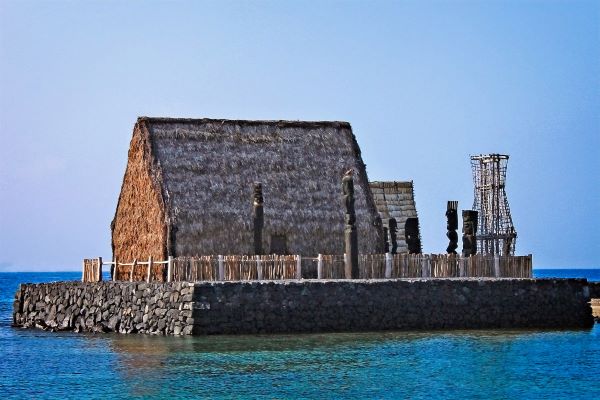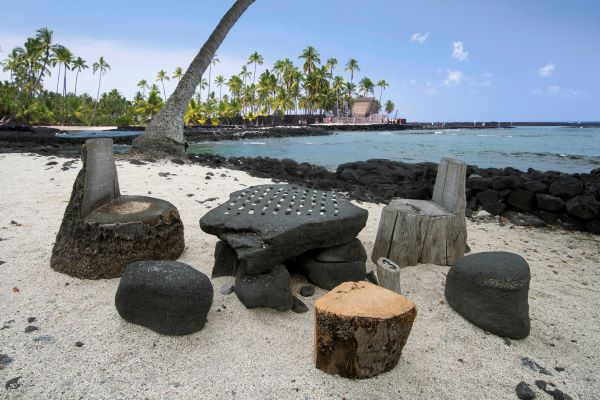Listed below are heiau throughout the Hawaiian Islands that are open to the public. If you don’t know what heiau are, or wonder why you would want to visit these ancient sites, we provide a brief description of their cultural value, followed by tips for visiting these historical treasures to make the most of your time. If you are looking for the “real” Hawai’i, this is a good place to be.

The personal heiau of King Kamehameha I, ‘Ahu’ena Heiau in Kailua-Kona on the Big Island – iStockphoto by Getty Images
What are heiau?
Heiau are remnants of sites used in ancient Hawai’i for many different purposes. They are often explained as being temples or places of worship, which greatly simplifies the complex nature of these culturally historic and very sacred places.
- Some were places to honor gods (akua) or ancestors (‘aumākua) with altars to make offerings (ho’okupu or mōhai) and recite prayers (pule) or chants (mele).
- Other heiau had a specific purpose, such as to prepare for war or planting season, to celebrate life events such as successful harvests and births, to train health practitioners and dispense medical services, to issue judgments against those who had broken laws (kapu), and to execute prisoners of war.
- In short, heiau were as important in ancient Hawai’i as are the many services on which we rely in the 21st century: getting food, praying and worship, seeing a doctor, handling legal and financial matters, protecting ourselves from enemies, etc.
Likewise, the structure of heiau varied according to their function.
- Some heiau were simple forms such as a stone column or earthen terrace.
- Others were elaborate structures with multiple platforms, chambers, walls, and fences. They could be constructed of any natural material, such as stone, wood, and thatching.
- The size of some stone heiau are particularly impressive since they were built without modern tools and without any kind of mortar (mud or clay) to stabilize the wall.

Simple stone structure at Pu’u o Mahuka Heiau State Historic Site on O’ahu – Depositphotos.com
Visiting heiau
The remains of many ancient heiau constructed hundreds of years ago can be found across the Hawaiian Islands.
Many heiau have been lost to the elements. Some were intentionally destroyed after the death of Kamehameha I in 1819. His son Liholiho abolished the kapu system, and along with it many heiau. Other heiau have been restored or are planned for restoration.
Whatever their current state may be today, all heiau and surrounding sites are considered sacred, having great mana (divine power) and carrying much significance in Hawaiian history and culture.
When visiting heiau, treat them with the same respect as you would any museum exhibit and the same reverence as any house of worship:
- Stay on marked paths—don’t step over walls or structures.
- Don’t rearrange stones or other elements that may be there.
- Don’t add any elements or take anything with you from the site.
- Traditionally, food items were left as offerings. However, please do not any items such as coins, incense, or candles, and do not wrap or move rocks, since these can cause long‐term damage to our fragile resources.
- Leave nothing behind but your footprints and take nothing but photographs and your memories.
The brochure Nā Wahi Pana: Respecting Hawaiian Sacred sites from the Hawai’i Departments of Land and Natural Resources is a good guide to visiting heiau and other sacred and storied culture sites in Hawaiʻi. Please kokua (cooperate, show respect).

Sign at the Poli’ahu Heiau on the Island of Kauai, Hawaii – iStockphoto by Getty Images
Heiau you can visit on every Hawaiian island
In the lists below, arranged by island, are some of the most significant heiau across all Hawai’i. Many are historical landmarks and most are free to visit. A few have nominal entrance fees.
Last time we checked, all were open to the public. However, occasionally heiau may be closed for restoration work; so, be flexible with your plans. There are many fascinating historical sites to visit in Hawai’i.
Heiau on Hawai’i Island
As the birthplace of the Hawaiian Kingdom, some of the most significant heiau in all of Hawai’i are on Hawai’i Island (aka the Big Island, because it is).
(Listed north to south along the western side of the Big Island, beginning in Hawi and ending at South Point.)
Mo’okini Heiau
Mo’okini Heiau is in the Kohala Historical Sites State Monument on the northwestern tip of Hawai’i Island near town of Hawi. It is one of the oldest heiau in the Hawaiian Islands. Tradition says a heiau was first built on this site by the high priest Mo’okini sometime in the 5th century. The current heiau was built on this older temple in the 13th or 14th century by the legendary Tahitian or Samoan priest Pa’ao as a luakini heiau (temple for human and animal sacrifice). Today, Mo’okini remains a most sacred site for Native Hawaiians.
Approximately 2,000 feet to the south of Mo’okini Heiau, is the Kamehameha I Birthsite at the Kapakai Royal Housing Complex. This is one of the few places in the Hawaiian Islands where historians know the exact location of an ali‘i (royal chief) housing complex and its associated heiau.
Pu’ukoholā Heiau
Pu’ukoholā Heiau is significant as the founding site of the Kingdom of Hawai‘i–it’s a complicated history rife with family and tribal conflicts. The site is not only a National Historic Landmark, but a national treasure. For Hawaiians, Pu`ukoholā is a symbol of unification and lasting peace.
‘Ahu’ena Heiau at Kamakahonu
Kamakahonu is a National Historic Landmark in Kailua-Kona on Kailua Bay is one of the most easily accessible sacred Hawaiian sites. While the original buildings are long gone, today the site has several reconstructed structures. It is especially important as the personal residence of King Kamehameha I (Kamehameha the Great), Hale Nana Mahina’ai.
- The complex included Kamehameha’s personal heiau, ‘Ahu’ena Heiau, along with other buildings and storage structures. Kamehameha used the heiau for council meetings.
- He died at Kamakahonu in 1819. The site eventually fell into disrepair by 1880. In 1960, King Kamehameha Hotel was built at the site.
- In the mid-1970s, the hotel underwent restoration, including a reconstruction of the heiau as well as Kamehameha’s residence, Hale Nana Mahina’ai. The site was restored under the direction of the Bishop Museum.
- In 2011, the heiau site was damaged by a tsunami and is currently undergoing restoration.
Keahou Heiau (Hāpaiali’i, Ke’ekū, Kapuanoni)
The ahupua’a (mountain-to-sea land divisions) of Kahalu’u and Keauhou on the Big Island have some of the most sacred heiau and other historical sites in Hawaiian legend. You can visit the Keauhou Kahalu’u Heritage Center in the Keahou Shopping Center to learn more about why this area is so special. Address: 78-6962 Kamehameha III Rd, Kailua-Kona, HI 96740. Admission to the Heritage Center is free.
Several important heiau in this area include: Hāpaiali’i Heiau, Ke’ekū Heiau, and Kapuanoni Heiau. Each of these heiau are described below.
‘Hāpaiali’i Heiau and Ke’ekū Heiau are located south of Kailua-Kona, near Kahalu’u Beach Park.
Hāpaiali’i dates to the 1400s and was reconstructed by Kamehameha Schools in 2007. The heiau platform measures 150 feet by 100 feet and was used for prayer. At high tide, Hāpaiali’i is surrounded by water. The sun sets on the southwest corner of the heiau at the winter solstice, the center point at the equinoxes, and the northwest corner at the summer solstice. It may have been used as a birthing heiau.
The adjacent Ke‘ekū Heiau is believed to have been constructed about 200 years after Hāpaiali’i. Ke’ekū is said to have been used to execute Chief Kamalālāwalu of Maui after he was defeated in the Battle of Hōkū‘ula by Chief Lonoikamakahiki of Hawai’i. Kamalālāwalu’s dogs, Kauakahi‘oka‘oka (a white dog) and Kapapako (a black dog,) are said to continue to guard this site. Outside the entrance to the heiau (towards the southwest) one of the petroglyphs on the pāhoehoe (smooth lava) is said to represent Kamalālāwalu.
Kapuanoni Heiau, located farther south on the grounds of the Outrigger Keauhou Beach Resort (just beyond the hotel pool) is believed to have been used for preparation of fish and foods.
More information about these heiau and many other sacred sites in the area is available in the Kamehameha Investment Corporation brochure: Ho‘iho‘i kū lana wahi pana (PDF).

Board game at Pu’uhonua O Hnaunau National Historical Park on the Big Island of Hawaii – Depositphotos.com
Pu‘uhonua O Honaunau
Pu’uhonua o Hōnaunau National Historical Park on Hōnaunau Bay is home to significant historical sites. The pu’uhonua (“place of refuge or peace and safety”) is enclosed by a massive 965-foot-long masonry wall. In acient times, it was a place for defeated warriors or those who committed kapu (sacred laws) to seek safety. For several centuries, the pu‘uhonua and the surrounding area was a primary religious and political center in the traditional district of Kona. Today, it remains a sacred place to anyone visits the site. Admission to Pu‘uhonua o Hōnaunau is $20 per car and includes up to eight passengers.
Heaiau at Pu‘uhonua O Honaunau: Hale o Keawe heiau, ‘Āle‘ale’a heiau believed to predate Hale o Keawe, and remnants of another ancient heiau, which is among the oldest structures in the park.
South Point Complex
South Point Complex on the southern cliffs of Hawai‘i Island is a National Historic Landmark and the southernmost point in the United States. The site was uncovered in 1956 by an archaeological team from Bishop Museum.
The complex rests on the flat, grassy, windswept cliffs above the ocean. It is believed to be the landing site of the first inhabitants to the islands. It is certainly one of the oldest settlements in the Hawaiian islands and includes remnants of a house, hearth, fishing paraphernalia, and salt flats.
The ancient Hawaiians constructed mooring holes to tether their canoes, which gave them safe access to deep sea fish from their canoes in the strong southerly ocean currents.
- Kalalea Heiau at the South Point complex was a ko’a (fishing shrine) to kū‘ula, god of fishing. The heiau has walls constructed of stone and a platform to prepare fish. Today, local fishermen visit this heiau to leave offerings in the hope of, or thanks for, a good fishing season. In addition, there are several large sacred stones in and around the heiau and throughout the complex honoring various deities associated with fishing, ocean voyages, and other aspects important to Hawaiian life.
South Point is also known for Papakolea Beach, one of only four green sand beaches in the world. (The other three are: Talofofo Beach on the island of Guam in the western Pacific Ocean; Punta Cormorant on Floreana Island, one of the Galapagos Islands in the eastern Pacific near the equator; and Hornindalsvatnet (Lake Hornindal) in southwestern Norway.)
- Papakolea Beach is 2.5 miles east of Kalalea Heiau. The green sand beach can be reached by vehicle or by hiking along the shoreline. Due to strong and treacherous ocean currents, swimming is not recommended.
Heiau on Kaua’i
Wailua Complex of Heiaus is located within Wailua River State Park. Designated a National Historic Landmark in 1962, the complex dates to the 14th Century. The historic Wailua ahupua‘a (traditional Hawaiian land division that runs from the mountains to the sea) includes several heiau: Poli’ahu Heiau, Malae Heiau, Hikinaakalā Heiau, and Kalaeokamanu.

Sunset above Wailua River in Kapaa on Kauai Island in Hawaii – iStockphoto by Getty Images
Heiau on Lana’i
Halulu Heiau is located within the Kaunolu Village Site on the southern cliffs of Lana‘i Island. The site dates to the 1400s and is the largest surviving ruins of an ancient village in the Hawaiian Islands. The village includes dozens of structures, including the Halulu Heiau. The site documents every aspect of life in a fishing village, including houses, gardens, fireplaces, terraces, pottery, game areas, and petroglyphs.
The Halulu Heiau was rebuilt by Kamehameha the Great after he captured the Island of Lanai in the early 1800’s. It was one of the last heiau built in the Hawaiian islands before his son and successor, Liholiho, brought an end to the kapu system and destroyed many of the heiau on the islands.
Heiau on Maui
Pi’ilanihale Heiau is in the Kahanu Garden at the National Tropical Botanical Garden near Hana on Mauiʻs remote eastern shore. The massive lava-rock structure is believed to be the largest man-made structure from ancient Polynesia and a National Historic Landmark. The heiau dates to the 13th centruy and is one of the best preserved sites in Hawai‘i. The heiau sat untouched and undisturbed until 1974. Overgrown and hidden, the area was restored by archaeologists from Bishop Museum and the State of Hawai‘i in 1999.
The Kahanu Garden is one of the largest, untamed native hala (Pandanus) forests in the Hawaiian Islands. The Kahanu plant collections focus on plants of value to the Hawaiian people and other Polynesian cultures. There is a self-guided walking trail through the garden to the heiau with interpretive signs along the way. Garden admission: $7/Kama‘aina, $12/general.
Heiau on Moloka’i
Hokukano-Ualapue Complex consists of seven heiau and two fishponds on the southeast coast of Molokai. The complex has more heiau and fishponds than any comparable area in the Hawaiian Islands. Some of the structures date to the 1200s and the site remained in use for 600 years. Each of the heiau had various uses, including agriculture, fishing, school of medicine, and a temple for ali’i (chiefs). The function of heiau could change over time according to the desires of the ali’i. Listed on the National Historic Register, Hokukano-Ualapue is an outstanding example of the engineering skills of early Hawaiians, as well as documenting life in ancient times.

View from the cliffs above Waimea Bay, site of Pu’u O Mahuka Heiau – Depositphotos.com
Heiau on O’ahu
(Beginning on the north shore and traveling clockwise around O’ahu.)
Pu‘u O Mahuka Heiau in the Pu‘u O Mahuka State Historic Site on the north shore of O‘ahu. Situated on cliffs 300 feet above Waimea Bay, it is the island’s largest heiau at almost two acres. At the mouth of Waimea Valley are two large heiau: Pu‘uo Mahuka on the north and Kupopolo on the south. Reportedly, signal fires at these heiau provided a means of visual communication with heiau on Kauai. The original site is believed to date from the 1600s, then expanded in the 1700s by a new ruling ali‘i (chief). More info: Pu’u O Mahuka Heiau brochure (PDF).
Hale o Lono Heiau in Waimea Valley on the north shore of O‘ahu was dedicated to Lono, Hawaiian god of agriculture. The heiau dates to the 1400s and was recently restored. Waimea Valley is one of the last intact ahupua’a (traditional mountain to sea land division) on the island of O’ahu. Many people visit to walk to the spectacular waterfall and stroll the botanical gardens with hundreds of rare and endangered plants. In addition to the heiau, there are several other significant Hawaiian cultural sites, including burial caves, shrines, and dozens of other structures.
Ulupō Heiau in the Ulupō State Historic Site near Kailua on the Windward Coast of Oahu. Listed on the National and Hawaii Registers of Historic Places, a visit to Ulupō Heiau can expand your knowledge of Hawaiian culture and history. The site was an agricultural center in the 1700s in the lush Kawai Nui region. It included fishponds, irrigated kalo (taro) lo’i (fields), and other cultivated crops including banana, sweet potato, and sugar cane. It’s use is believed to have changed later from an agricultural heiau to a luakini or war heiau.
Kūka‘ō‘ō Heiau in Honolulu’s lush Mānoa Valley is a māpele heiau (thatched temple), dedicated to Lono, god of agriculture, rain and fertility. Restored in 1993 by expert Hawaiian dry-stack mason, Billy Fields, Kūka‘ō‘ō Heiau survives as the last remaining intact Hawaiian temple in the greater ahupua‘a (land district) of Waikīkī and a timeless link to the past.
Keaīwa Heiau is located at the entrance to Keaiwa Heiau State Recreation Area, a 384-acre park located approximately 12 miles from Waikiki. It is also the location for the popular ‘Aiea Loop Trail. Keaīwa Heiau was a healing heiau, what we would call a medical clinic, tended by kahuna (doctors) who were trained in healing arts using native plants. The kahuna would take on apprentices to learn and practice the necessary skills. The site was restored in 1951.
Other heiau on O‘ahu are closed to visitors. including: Kane’aki Heiau in the Makaha Valley, Pahua Heiau in Waimānalo Ahupua‘a, Pahukini Heiau near Kailua, Kawa’ewa’e Heiau near Kanehoe, and Ulehawa Historic Site in Waianae. Closures are due to various reasons, such as restoration work, to preserve ancient sites from overuse, or to reserve sites for educational use. Please kokua.
